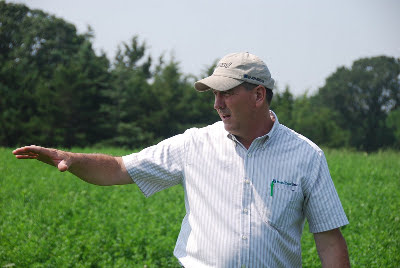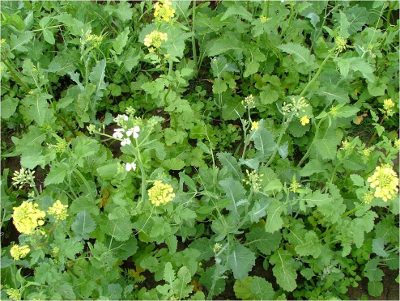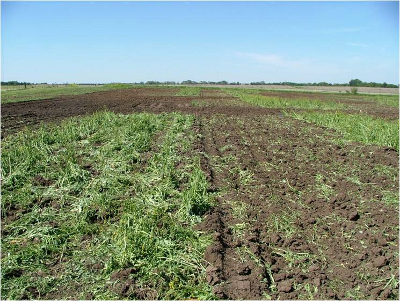
Dallefeld on cover crops
 Karl Dallefeld spoke at the
ACRES USA conference about "capturing maximum value from diversity of
plant species on your farm", mostly in relation to mixtures of cover
crops. Dallefeld has experimented extensively with cover crops on
his eastern Iowa farm, and much of his talk consisted of a who's who of
top cover crops for various applications. His recommendations by
category include:
Karl Dallefeld spoke at the
ACRES USA conference about "capturing maximum value from diversity of
plant species on your farm", mostly in relation to mixtures of cover
crops. Dallefeld has experimented extensively with cover crops on
his eastern Iowa farm, and much of his talk consisted of a who's who of
top cover crops for various applications. His recommendations by
category include:
- Scavenging nitrogen - rye, sorghum-sudangrass, radish, rapeseed, ryegrass
- Nitrogen fixation - legumes (especially clovers)
- Quick spring cover - buckwheat, sorghum-sudangrass, berseem clover, medic
- Late planted winter cover
- annual ryegrass, rye, oats, radish, rape, turnips
- Erosion control - barley, rye, sorghum-sudangrass, cowpeas
- Building soil - rye, sorghum-sudangrass, sweetclover, woollypod and hairy vetch
- Loosening compacted soil - radish
- Suppressing nematodes - brassicas (only if tilled in)
- Dealing with high pH - mustard, berseem clover, ryegrass, vetch
- Fighting weeds - rye, oats, buckwheat, radish, berseem clover, chickling and other vetches, cowpeas, subclover
- Quick, temporary pastures - annual ryegrass, oats, wheat, sorghum-sudangrass, berseem clover, crimson clover, white clover, red clover
 You'll notice that most
categories include several options, and Dallefeld prefers to mix lots
of species together when planting cover crops. His goal is to
include at least one legume, one grass, and one non-legume forb (aka
everything else) in each mixture, on the assumption that a more diverse
cover crop assortment will do its job better. For example, he
might plant mustard, berseem clover, ryegrass, and a vetch all at once,
figuring that the clover and vetch will add nitrogen to the soil, the
mustard will feed pollinators and reduce the number of nematodes, and
the ryegrass will build organic matter.
You'll notice that most
categories include several options, and Dallefeld prefers to mix lots
of species together when planting cover crops. His goal is to
include at least one legume, one grass, and one non-legume forb (aka
everything else) in each mixture, on the assumption that a more diverse
cover crop assortment will do its job better. For example, he
might plant mustard, berseem clover, ryegrass, and a vetch all at once,
figuring that the clover and vetch will add nitrogen to the soil, the
mustard will feed pollinators and reduce the number of nematodes, and
the ryegrass will build organic matter.
I was particularly
struck by Dallefeld's explanation of when to kill cover crops depending
on your goals. He explains that young, succulent plants (like
buckwheat at the bloom stage) provide quick nutrients while lignified
(aka mature and woody) cover crops tie up nutrients at first, but end
up building humus in the long run. That's why we use
buckwheat in the summer in short windows between vegetables and save
oats for over-wintering, since the latter have time to rot down a
bit before we plant into them the next year.
 Dallefeld's experiences are
with cover crops in their mainstream, large-scale application.
Generally, he sows cover crops into newly tilled fields and then tills
them back into the ground before planting a vegetable, so you should be
careful about using his favorite varieties in a no-till garden.
Still, we can all take his wisdom to heart --- more diversity in the
garden is nearly always better. Maybe I need to continue
expanding my selection of cover crops beyond the tried and true.
Dallefeld's experiences are
with cover crops in their mainstream, large-scale application.
Generally, he sows cover crops into newly tilled fields and then tills
them back into the ground before planting a vegetable, so you should be
careful about using his favorite varieties in a no-till garden.
Still, we can all take his wisdom to heart --- more diversity in the
garden is nearly always better. Maybe I need to continue
expanding my selection of cover crops beyond the tried and true.
| This post is part of our ACRES conference lunchtime series.
Read all of the entries: |
Want more in-depth information? Browse through our books.
Or explore more posts by date or by subject.
About us: Anna Hess and Mark Hamilton spent over a decade living self-sufficiently in the mountains of Virginia before moving north to start over from scratch in the foothills of Ohio. They've experimented with permaculture, no-till gardening, trailersteading, home-based microbusinesses and much more, writing about their adventures in both blogs and books.
Want to be notified when new comments are posted on this page? Click on the RSS button after you add a comment to subscribe to the comment feed, or simply check the box beside "email replies to me" while writing your comment.
